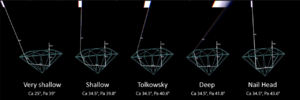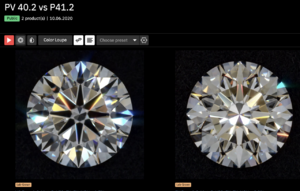Gemly
Shiny_Rock
- Joined
- May 29, 2020
- Messages
- 293
Just trying to sharpen my understanding.
I know a smaller table tends to produce more fire. I also know a higher crown angle produces more fire. So if I’m comparing a diamond with a slightly higher crown angle vs one with a slightly smaller table, which then would produce more fire? Looking at the three sample parameters below which (theoretically) should be most firey?
Examples: Assuming all 3 have 15.5% crown height
Diamond #1
Table size: 54.5%
CA: 34.4
PA: 40.8
Diamond #2
Table size: 55%
CA: 34.5
PA: 40.7
Diamond #3
Table size: 55.5%
CA: 34.6
PA: 40.7
Thanks so much for your help! I have appts to meet with some venders in the next couple of weeks and am getting prepared.
I know a smaller table tends to produce more fire. I also know a higher crown angle produces more fire. So if I’m comparing a diamond with a slightly higher crown angle vs one with a slightly smaller table, which then would produce more fire? Looking at the three sample parameters below which (theoretically) should be most firey?
Examples: Assuming all 3 have 15.5% crown height
Diamond #1
Table size: 54.5%
CA: 34.4
PA: 40.8
Diamond #2
Table size: 55%
CA: 34.5
PA: 40.7
Diamond #3
Table size: 55.5%
CA: 34.6
PA: 40.7
Thanks so much for your help! I have appts to meet with some venders in the next couple of weeks and am getting prepared.











300x240.png)